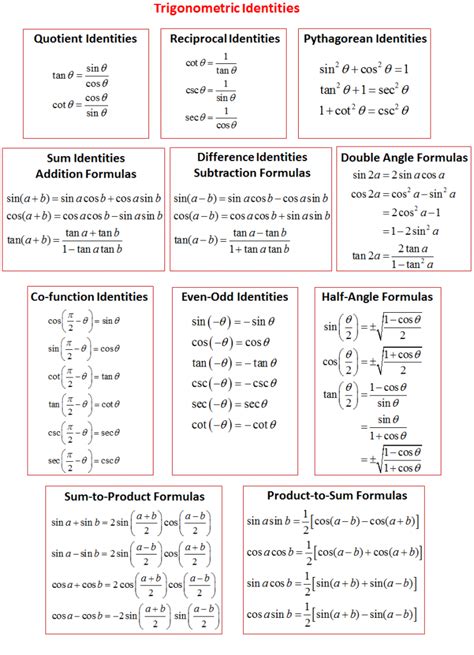The Pythagorean identities are a fundamental concept in trigonometry, providing a powerful tool for solving equations and simplifying expressions. These identities are derived from the Pythagorean theorem, which states that in a right-angled triangle, the square of the length of the hypotenuse (the side opposite the right angle) is equal to the sum of the squares of the lengths of the other two sides. In this article, we will explore the three Pythagorean identities, their derivations, and their applications in trigonometry.
Key Points
- The Pythagorean identities are derived from the Pythagorean theorem and are used to simplify trigonometric expressions.
- The three Pythagorean identities are: $\sin^2(x) + \cos^2(x) = 1$, $1 + \tan^2(x) = \sec^2(x)$, and $\cot^2(x) + 1 = \csc^2(x)$.
- These identities are essential in solving trigonometric equations, simplifying complex expressions, and proving various trigonometric identities.
- The Pythagorean identities have numerous applications in mathematics, physics, engineering, and other fields, including the study of periodic phenomena, wave patterns, and geometric transformations.
- Understanding the Pythagorean identities and their applications is crucial for advancing in mathematics and science, as they provide a foundation for more advanced concepts and techniques.
Derivation of the Pythagorean Identities

The Pythagorean identities can be derived from the Pythagorean theorem by using the definitions of the trigonometric functions. The first Pythagorean identity, \sin^2(x) + \cos^2(x) = 1, can be derived by considering a right-angled triangle with angle x, opposite side a, adjacent side b, and hypotenuse c. Using the definitions of sine and cosine, we have \sin(x) = \frac{a}{c} and \cos(x) = \frac{b}{c}. Substituting these expressions into the Pythagorean theorem, a^2 + b^2 = c^2, we get \left(\frac{a}{c}\right)^2 + \left(\frac{b}{c}\right)^2 = 1, which simplifies to \sin^2(x) + \cos^2(x) = 1.
Derivation of the Second and Third Pythagorean Identities
The second and third Pythagorean identities can be derived from the first identity by using the definitions of the trigonometric functions. The second Pythagorean identity, 1 + \tan^2(x) = \sec^2(x), can be derived by using the definition of tangent, \tan(x) = \frac{\sin(x)}{\cos(x)}, and the definition of secant, \sec(x) = \frac{1}{\cos(x)}. Substituting these expressions into the first Pythagorean identity, we get 1 + \left(\frac{\sin(x)}{\cos(x)}\right)^2 = \left(\frac{1}{\cos(x)}\right)^2, which simplifies to 1 + \tan^2(x) = \sec^2(x). Similarly, the third Pythagorean identity, \cot^2(x) + 1 = \csc^2(x), can be derived by using the definition of cotangent, \cot(x) = \frac{\cos(x)}{\sin(x)}, and the definition of cosecant, \csc(x) = \frac{1}{\sin(x)}.
| Pythagorean Identity | Derivation |
|---|---|
| $\sin^2(x) + \cos^2(x) = 1$ | Derived from the Pythagorean theorem using the definitions of sine and cosine |
| $1 + \tan^2(x) = \sec^2(x)$ | Derived from the first Pythagorean identity using the definitions of tangent and secant |
| $\cot^2(x) + 1 = \csc^2(x)$ | Derived from the first Pythagorean identity using the definitions of cotangent and cosecant |

Applications of the Pythagorean Identities

The Pythagorean identities have numerous applications in mathematics, physics, engineering, and other fields. They are used to simplify complex trigonometric expressions, solve equations, and prove various trigonometric identities. In physics, the Pythagorean identities are used to describe the motion of objects in terms of their position, velocity, and acceleration. In engineering, they are used to design and analyze systems, such as bridges, buildings, and electronic circuits. The Pythagorean identities are also used in computer science, navigation, and other fields, where they provide a foundation for more advanced concepts and techniques.
Examples of Applications
One example of the application of the Pythagorean identities is in the study of periodic phenomena, such as sound waves and light waves. The Pythagorean identities can be used to describe the relationships between the frequency, amplitude, and phase of these waves. Another example is in the study of geometric transformations, such as rotations and reflections. The Pythagorean identities can be used to describe the relationships between the coordinates of points in different coordinate systems.
In conclusion, the Pythagorean identities are a fundamental concept in trigonometry, providing a powerful tool for simplifying expressions and solving equations. By understanding the derivations and applications of these identities, students can develop a deeper appreciation for the subject and improve their problem-solving skills. The Pythagorean identities have numerous applications in mathematics, physics, engineering, and other fields, making them an essential part of any mathematical or scientific education.
What are the three Pythagorean identities?
+The three Pythagorean identities are: \sin^2(x) + \cos^2(x) = 1, 1 + \tan^2(x) = \sec^2(x), and \cot^2(x) + 1 = \csc^2(x).
How are the Pythagorean identities derived?
+The Pythagorean identities are derived from the Pythagorean theorem using the definitions of the trigonometric functions.
What are some applications of the Pythagorean identities?
+The Pythagorean identities have numerous applications in mathematics, physics, engineering, and other fields, including the study of periodic phenomena, wave patterns, and geometric transformations.
Why are the Pythagorean identities important?
+The Pythagorean identities are important because they provide a powerful tool for simplifying expressions and solving equations, and they have numerous applications in various fields.
How can I use the Pythagorean identities to solve problems?
+You can use the Pythagorean identities to solve problems by substituting them into equations and expressions, and then simplifying and solving for the unknown variables.



